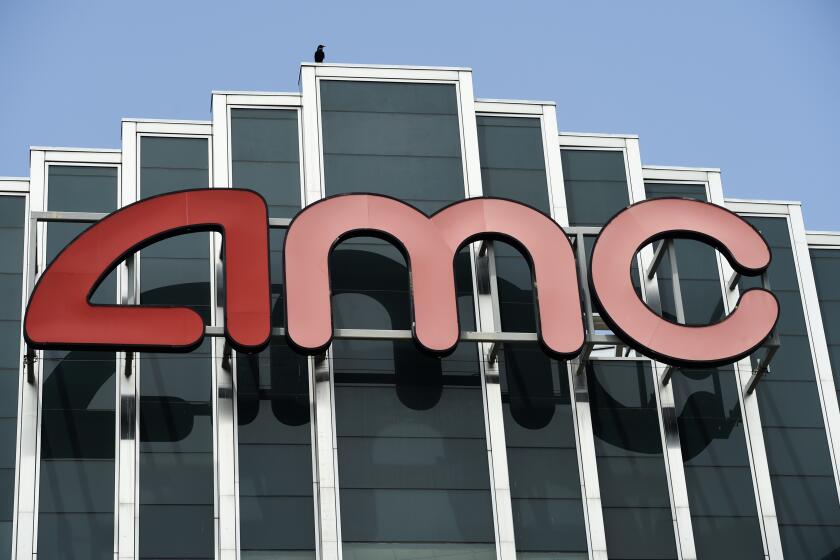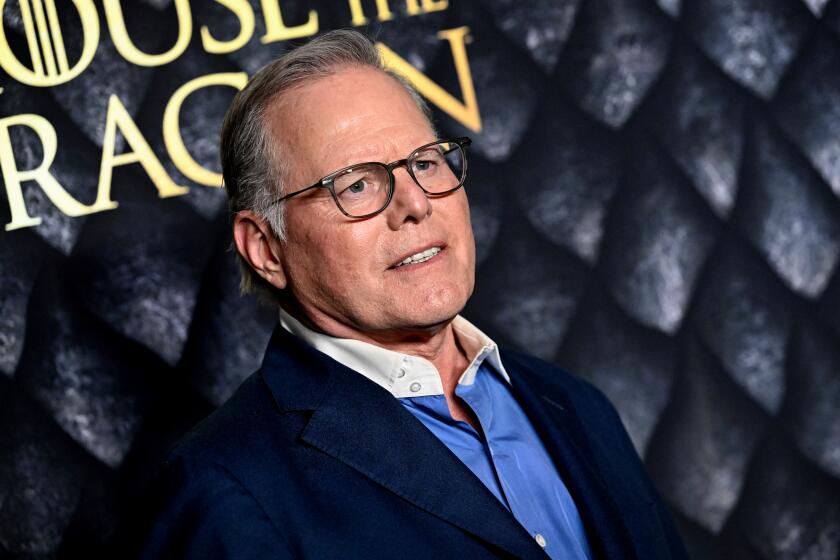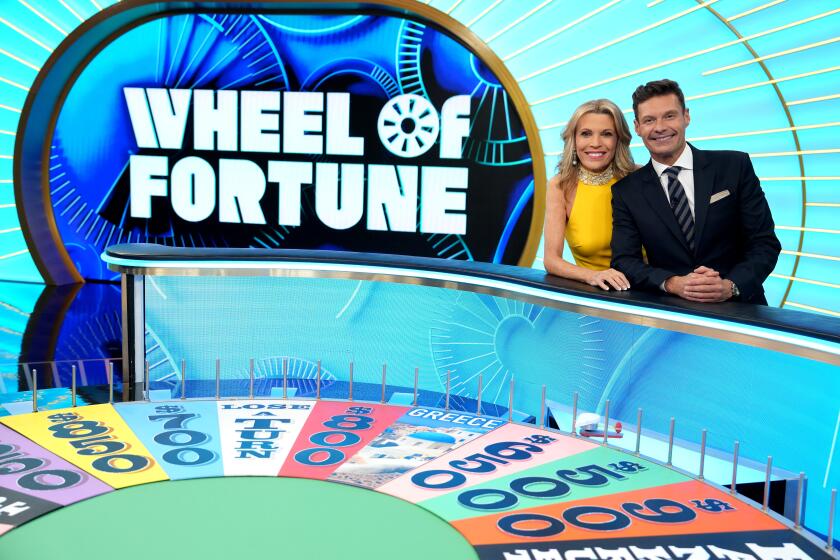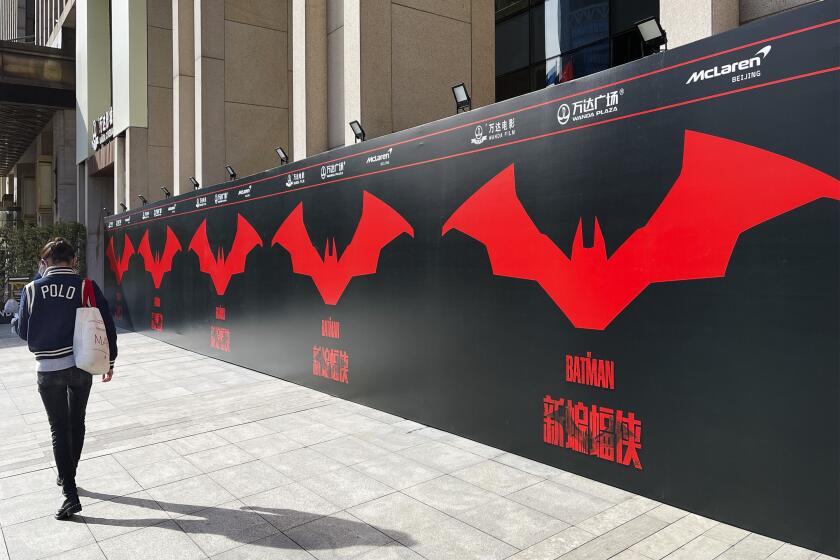Movie theaters make plea for more films, rail against piracy at CinemaCon 2024
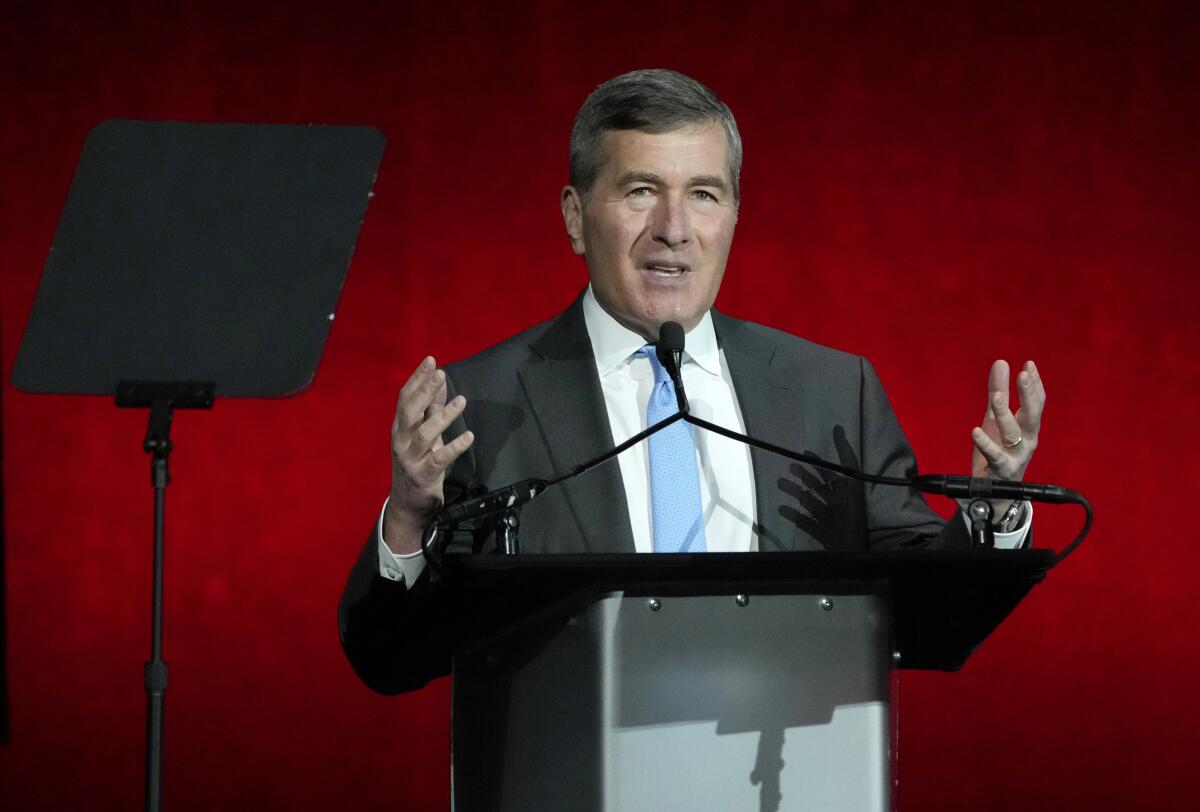
- Share via
Somehow, heartbreak feels good in a place like CinemaCon — where no matter how many hits the motion picture industry has taken over the last year (and, uh, it’s taken a lot), exhibitors from all over the world unfailingly come together to exude enthusiasm about the moviegoing experience and optimism about the future of cinema.
Flag bearers for the Motion Picture Assn., the National Assn. of Theatre Owners and other major industry players convened Tuesday at Caesars Palace in Las Vegas to deliver their annual state-of-the-business address and officially kick off the event. Movie stars, filmmakers and studio heads are expected to tease, extol and in some cases screen their upcoming releases.
There’s a lot riding on those movies in the wake of a box office slump partially brought on by the Hollywood writers’ and actors’ strikes, which delayed several movies and effectively halted film and TV production last year for about six months.
CinemaCon, the annual film industry conference in Las Vegas, is set to rally support for theaters amid a thin 2024 box office slate.
“We can’t shy away from the stark challenges of this moment, nor can we ignore this time of volatility in our industry,” said Charles Rivkin, chief executive of the MPA, during Tuesday’s presentation. Washington-based MPA represents the Hollywood studios, including Disney and Netflix.
“Yet no one should fear that uncertainty,” he added, “because after all, we work in a business where unexpected twists can make for an epic story. ... We understand the stakes. We recognize the need to do everything possible to ensure the enduring health of cinema.”
Global box office revenue is predicted to hit $32 billion in 2024, according to film analytics firm Gower Street, which is nowhere near the $40-billion-plus heights of the pre-COVID-19 era. But since the beginning of 2024 — when domestic box office revenue was down 20% from the previous year — some glimmers of hope have emerged.
In March, the highly anticipated sequel to Warner Bros.’ “Dune” launched at $82.5 million in the United States and Canada — the first true blockbuster opening weekend since AMC Theatres’ “Taylor Swift: The Eras Tour” ($93.2 million).
This year’s Oscar nominees did strong business at the box office. But the year ahead is uncertain after a shaky winter.
Following the desperately needed success of “Dune: Part Two” — which has now grossed more than $255 million domestically — Universal Pictures’ “Kung Fu Panda 4” notched a solid $58-million domestic debut, Sony Pictures’ “Ghostbusters: Frozen Empire” posted a decent $45 million and Warner Bros.’ “Godzilla x Kong: The New Empire” drew an impressive $80-million bow.
Exhibitors on Tuesday also touted the rising popularity of Japanese cinema in the United States, including Crunchyroll-distributed anime hits such as the latest “Demon Slayer” movie and Toho Co.‘s Oscar-winning “Godzilla Minus One.”
Mitchel Berger, senior vice president of global commerce at Crunchyroll, said Tuesday that the global anime business generated $14 billion a decade ago and is projected to generate $37 billion next year.
“Anime is red hot right now,” Berger said.
“Fans have known about it for years, but now everyone else is catching up and recognizing that it’s a cultural, economic force to be reckoned with.”
The box office in 2024 is expected to come in at around $8 billion in the U.S. and Canada, or $1 billion lower than last year. But movies themselves can still be healthy.
Exhibitors are hoping that momentum holds despite also weathering several recent box office disappointments, such as Universal Pictures’ misbegotten spy thriller “Argylle” and Sony Pictures’ superhero disaster “Madame Web.”
When the actors’ strike concluded in November, theater operators expressed concerns about the health of the 2024 film slate. The overlapping work stoppages prompted studios to push at least a dozen movies to 2025 from 2024, including the eighth installment in Paramount Pictures’ “Mission: Impossible” saga and Disney’s live-action remake of “Snow White.”
Cinemark Chief Executive Sean Gamble estimated in February that 95 pictures were slated to open this year in wide release, as opposed to 110 in 2023. And nothing spells danger for exhibitors like a thinned-out release schedule. It doesn’t help that the average length of the theatrical window significantly shrank (from 90 days to roughly 35 to 40 days) after the COVID-19 pandemic shut down movie theaters for more than a year.
“Bob Marley” One Love” stays strong, but “Ordinary Angels” and “Drive-Away Dolls” kept audiences away at the weekend box office.
At Tuesday’s presentation, exhibitors pleaded with distributors to take a leap of faith and commit to releasing movies in cinemas year-round — not just during times that have historically seen heavier foot traffic.
“For my friends in distribution, please embrace digital’s flexibility and offer your awe-inspiring movies 52 weeks of the year to every exhibitor,” said Chris Johnson, CEO of Classic Cinemas. “Eliminate print counts and trust us to make programming and scheduling decisions that yield the best results for all. ... If you have a hit, we will hold it.”
Michael O’Leary, CEO of the National Assn. of Theatre Owners, also made the case for more small- and medium-budget releases that attract cinephiles, citing prestige titles such as A24’s “Past Lives” and Amazon MGM Studios’ “American Fiction.”
“It’s not enough for us to simply sit back and want more movies,” O’Leary said. “We must work with distribution to get more movies of all sizes to the marketplace.”
AMC Entertainment shares fell about 15% shortly after the theater chain indicated that it could sell up to $250 million worth of stock to pad its finances after a period of box office woes.
This year, a number of potential upcoming blockbusters remain.
Universal is cooking up “Twisters,” “Wicked” and “Despicable Me 4”; Warner Bros. is sitting on “Furiosa: A Mad Max Saga,” “Joker: Folie à Deux” and “Beetlejuice Beetlejuice”; Paramount is distributing “Gladiator 2” and “A Quiet Place: Day One”; Sony is launching “Venom: The Last Dance”; Disney is set to release “Inside Out 2,” “Moana 2” and “Deadpool & Wolverine”; and Amazon MGM Studios is about to drop “Challengers,” starring Zendaya.
The last few years at CinemaCon have drawn battle lines between exhibitors and streamers. During the streaming wars of 2021 and 2022, studios threw an excessive amount of resources and funds at streaming projects in an effort to compete with Netflix.
CinemaCon in Las Vegas highlights the movie theater industry’s ongoing recovery, with stars and studios committing to exclusive theatrical releases — again.
At the time, streaming was painted as theaters’ archnemesis. But the great streaming boom of the early 2020s has subsided as entertainment companies — reeling from financial losses — are tightening their belts and greenlighting less streaming content.
In December, Disney unveiled plans to re-release three Pixar titles — “Soul,” “Turning Red” and “Luca” — in theaters this year after initially routing them directly to streaming. Additionally, “Moana 2” — originally conceived as a TV series to be streamed on Disney+ — was reworked into a feature coming to the big screen in November.
Though streaming undoubtedly still poses a threat to movie theaters, the tides appear to be turning ever so slightly in exhibitors’ favor as studios rethink their release strategies and film fanatics continue to splurge on Imax and other premium large formats.
“You can watch a movie on TV or on your tablet or on your computer, but you experience it in a theater,” O’Leary said. “And part of what makes the movie so special is the theaters themselves.”
Online piracy continues to thrive amid a rise in streaming websites, according to a report released Tuesday by Internet safety organization Digital Citizens Alliance and consulting firm MediaLink.
However, exhibitors at CinemaCon did repeatedly express concerns about the rise of illegal streaming and digital piracy. Rivkin condemned the practice as “insidious forms of theft” that harm production workers, actors, directors, writers, craftspeople and even consumers who risk falling prey to malware viruses when watching movies illegally online.
Rivkin estimated that on average, piracy costs the movie theater industry more than $1 billion per year. During his state-of-the-industry address, he called on Congress to enact site-blocking legislation that would prevent internet users in the United States from accessing websites that stream films illegally.
“Piracy operations have only grown more nimble, more advanced and more elusive every day,” Rivkin said. “These activities are nefarious by any definition. They’re detrimental to our industry by any standard. And they’re dangerous for the rights of creators and consumers by any measure.”
More to Read
Inside the business of entertainment
The Wide Shot brings you news, analysis and insights on everything from streaming wars to production — and what it all means for the future.
You may occasionally receive promotional content from the Los Angeles Times.




